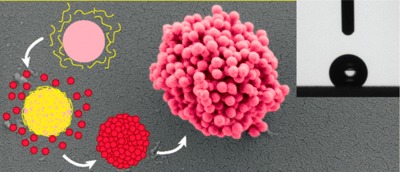Researchers create "sticky tape for water droplets"
Researchers at the University of Sydney have developed a new material which uses raspberry particles (so called because of their appearance) to trap tiny water droplets and prevent them from rolling off surfaces.
Dr Andrew Telford, the lead author of the research, explained that raspberry particles mimic the surface structure of some rose petals, which cause water droplets to “bead up in a spherical shape … [which] is a sign the flower is highly water-repellent”.

The research team set out to replicate the rose petal by assembling raspberry particles in the lab using spherical micro- and nanoparticles. The result is that water droplets bead up when placed on films of the raspberry particles and they are not able to drip down from it, even when turned upside down.
Dr Telford described the raspberry particle films as “sticky tape for water droplets”. He said the ability to immobilise very small droplets on a surface is a significant achievement with innumerable potential applications.
The breakthrough could help rapidly process simple medical tests on freestanding droplets, with the potential for very high turnover of tests with inexpensive equipment and in remote areas. It could also be useful in preventing condensation issues in aeroplane cabins.
Furthermore, noted Dr Telford, the nanotechnology could be used to influence how surfaces interact with water. “This means we will be able to design a surface that does whatever you need it to do.”
He imagined designing a surface “that stays dry forever, never needs cleaning or able to repel bacteria or even prevent mould and fungi growth … We could then tweak the same structure by changing its composition so it forces water to spread very quickly.”
Dr Telford said the research is commercially viable, as it is the first discovery “that allows for the preparation of raspberry particles on an industrial scale”.
The researchers stated, “Since all particles were synthesised from scratch by surfactant-free emulsion polymerisation in air and every step of the protocol was performed in water, this platform is upscalable and environmentally friendly.”
The research was supported through an Australian Research Council Linkage Project grant. It has been published in the journal Chemistry of Materials.
'Optical tweezers' could help study living cells
Physicists are using the tweezers to measure activity within microscopic systems over timeframes...
Aerosol test for airborne bird flu developed
The low-cost sensor detects the virus at levels below an infectious dose and could lead to rapid...
Superelastic alloy functions in extreme temperatures
The titanium-aluminium superelastic alloy is not only lightweight but also strong, offering the...




